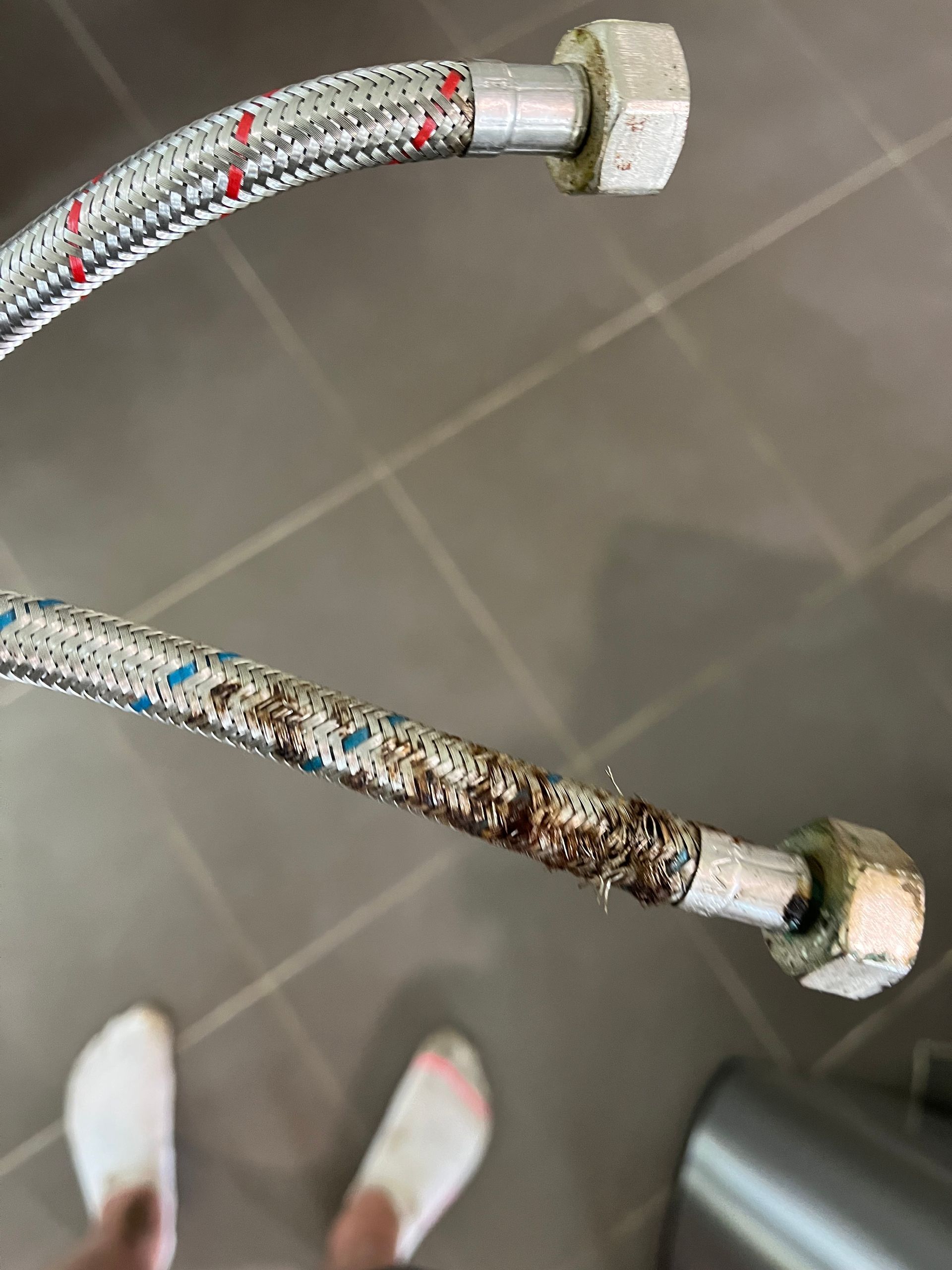1300 508 157
Avoiding Serious Water Damage from a Burst Flexi Hose - Solutions to Flexible Plumbing Hose Problems
Understanding Flexi Hoses - Benefits, Risks, and Maintenance Tips
Flexible plumbing hoses, or flexi-hoses, are rubber pipes surrounded by braided lengths of stainless steel. They’re used to connect water to taps and fixtures, so you’ll usually find them under the sinks, in your bathroom, laundry, or kitchen. These flexible hose pipes reduce the stress on pipes by absorbing hydraulic shock and ground movement. Failing to inspect these hoses regularly could result in a burst flexi hose, causing significant water damage. Regular inspection and maintenance can help prevent these flexible plumbing hose problems.
Flexible hoses, flexi hoses, or flexible connectors, came onto the Australian plumbing market around 30 years ago and have since become extremely popular. If you look under your kitchen sink, in your laundry, behind your toilet, or behind most plumbing fixtures, you will probably notice one or several of these features.
However, they are not without risks to your home. If not checked and maintained properly, you can end up with a burst flexi hose, leading to heavy flooding and damage to your home or workplace. Common flexible plumbing hose problems include leaks, kinks, and wear that can result in unexpected failures.
What are the advantages of using flexi hoses?
These hoses are flexible (as the name would suggest) so easy to manoeuvre or install, as well as easy to replace. They’re versatile and come in many shapes and sizes so they can be bent and shaped to accommodate your water supply. Quick to install, they overcome tricky alignment issues, reducing labor costs.
Tips for choosing the best flexible hose
- Don't choose the cheaper option - you get what you pay for!
- Check the warranty that comes with the flexi hose
- Check the braid - the thinner the braid the weaker the hose
- Ensure the flexi hose has the WaterMark certification
We also recommend always having your flexi hoses installed by a reliable and qualified plumber. This is to ensure they are installed correctly and that you are safe from being the victim of a flexi flood.
How long does a flexi hose last?
Generally, stainless steel flexible hoses will need replacing every 5 years. Before you find yourself in deep water, it’s wise to check hoses regularly, preferably by a professional plumber. Look for signs of aging, such as bulges, kinks, frayed areas, or rust spots on the braided section of the pipe.
Make sure you also check the warranty period and expiry dates. If your hoses have reached their shelf life, or are showing any signs of wear, get in touch with Chiswick Plumbing today.
Despite their relatively long shelf life, recent data released by insurance companies show that flexi hoses are the number one cause of internal flooding in Australian homes. Burst flexible water hoses cause more than 20% of water damage claims, sometimes bursting within months of their installation. As a single flexi hose can leak up to 1,500 litres of water per hour, this can lead to irreversible water damage to your house
Why does a flexi hose burst, and what are the common causes of a burst flexi hose?
The rubber tube inside a flexi hose expands under pressure, and the stainless steel braid is designed to control the rubber tube and prevent further expansion. However, if the stainless steel fails and breaks, water pressure will cause the rubber lining to bulge out of the sleeve and rupture.
Factors that may cause your flexi-hose to burst during installation include:
- Twisting or stretching the hose
- Improperly tightened nuts at either end of the connectors
- Exposure to high humidity, leading to corrosion of the stainless steel braiding
Did you know a burst flexi-hose can leak up to 1,500 liters of water per hour? This can cause severe and potentially irreversible damage to your home; like flooding your home and damaging carpets, walls, flooring, and furniture.
Flexible hoses used in closed cupboards under sinks are most at risk due to the high humidity environment caused by condensation. This is especially true for cupboards where household chemicals are stored. Those chemicals often contain chlorine which stays in the air in the closed cabinet and dissolves into hydrochloric acid under humidity, corroding the stainless steel braiding of the flexi hose.
Flexible Plumbing Hose Problems Near You
Preventing bursts in your flexible plumbing hoses is crucial to avoid the common and costly problem of a burst flexi hose. Regular maintenance is much cheaper than damage repair, and it’s important to address flexible plumbing hose problems before they escalate. A good time to get a plumber to perform a maintenance check is before you go on holiday, as many issues occur when families are out of town and only discover the disaster upon their return.
Here are some tips for preventing bursts in your flexible plumbing hoses:
- Choose Quality Hoses: Always buy a good quality brand of flexi hose with WaterMark certification, and ensure they are installed by a licensed plumber.
- Implement Preventative Maintenance: Talk to your plumber about starting a preventative maintenance program to regularly check your flexi hoses for damage or leaks, helping to protect your property from potential floods.
- Install Mini Stop Valves: Add mini stop valves on all water lines with flexible hose connections. This allows you to easily isolate the hoses in case of an emergency.
- Improve Ventilation: Install a vent hole in cupboards to allow for ventilation, which reduces humidity and chlorine levels. This is especially important in closed cupboards where household chemicals are stored. Alternatively, consider removing chemicals from under the sink where a flexi hose is present.
- Turn Off Water Supply During Absences: Switch off the main water supply of your home when you are going away for an extended period. Additionally, booking a plumbing check-up before you leave can prevent unexpected issues.
If you notice any damage on your flexi hose or need a local plumber to install a replacement or maintain flexible hosing, Chiswick Plumbing can help. In case of flooding from a burst flexi hose, turn off the main water supply immediately and give us a call.
By taking these steps, you can significantly reduce the risk of flexible plumbing hose problems and avoid the hassle and expense of dealing with a burst flexi hose.
Chiswick Plumbing is available 24/7 for all your plumbing needs! Our team is equipped with the right tools to provide same-day emergency plumbing services near you to address any issues, including burst flexi hoses and other flexible plumbing hose problems. Call us at 1300 508 157- day or night!




